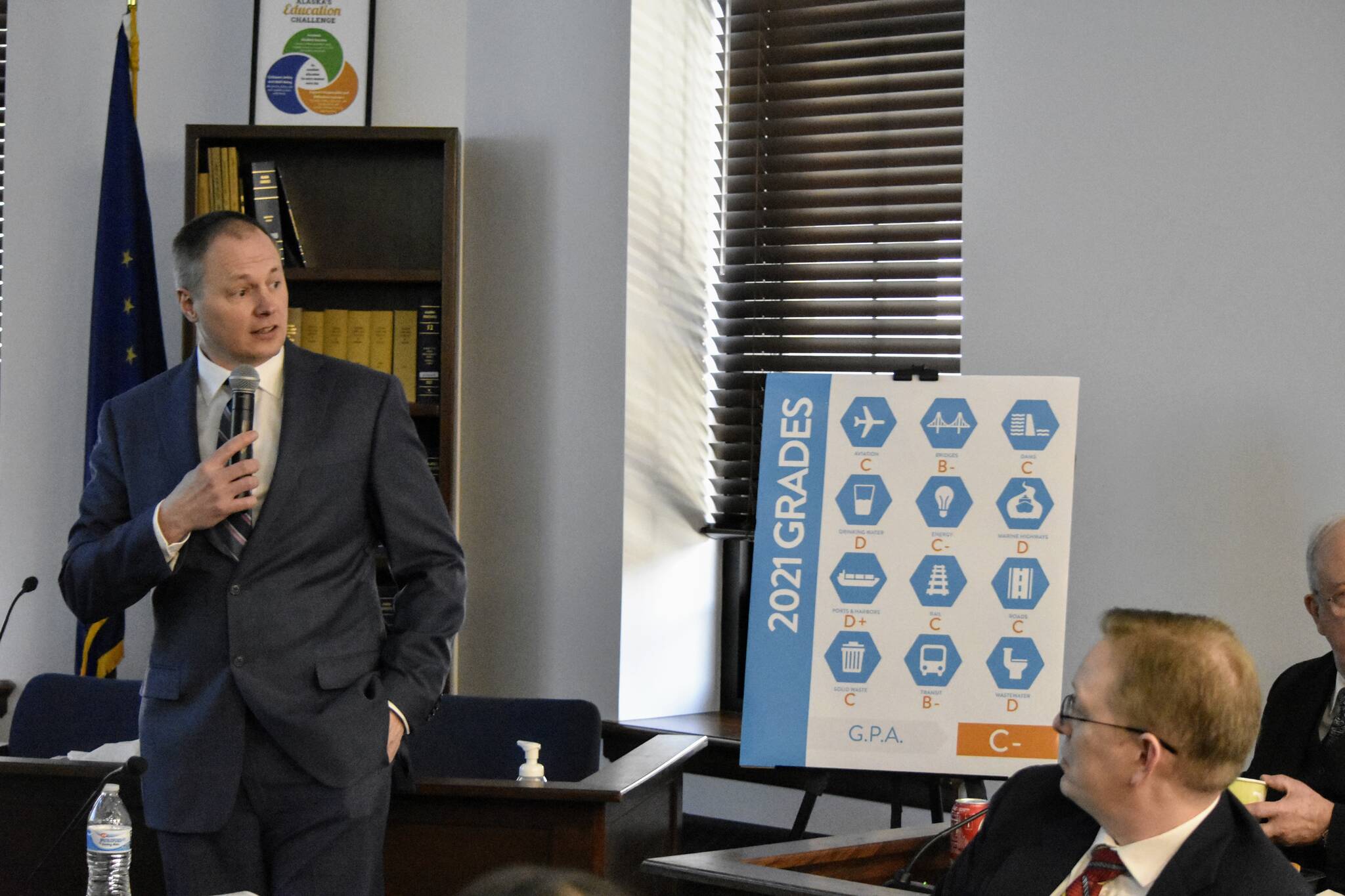Alaska’s infrastructure earned a C- grade in a recent “report card” from the American Society of Civil Engineers that analyzed and graded the state’s infrastructure assets.
In a presentation at the Capitol Wednesday, ASCE Alaska Section engineers presented on challenges faced by the state’s roads, transit, wastewater and other infrastructure assets and made recommendations for improvements.
“We want to raise awareness about infrastructure needs, we want to inform the public and advocate for solutions,” said ASCE Alaska engineer Doug Simon. “The report card is meant to inform from the perspective of engineers.”
Softening the blow a bit, Simon said the ideal grade was somewhere around a B, and an A could mean a particular aspect of infrastructure is overbuilt. The national grade in 2021 was also a C-, Simon said.
In looking at the state’s infrastructure, the need for maintenance was a major issue. Much of the state’s current infrastructure was in need of deferred maintenance and ASCE recommended lawmakers take future maintenance costs into consideration when looking at projects.
The only categories of state infrastructure to receive a grade of B – were transit and bridges, according to ASCE’s report card, all others received a C or D grade. No categories received an F.
[Masks now optional in state Capitol]
Transit received a higher grade because the state’s four main population centers were well serviced by public transit, said ASCE’s David Gamez. Additionally, many of the state’s bridges were among of the newest in the country, Gamez said but were reaching an age where maintenance issues were increasingly important.
Engineers noted the state’s size, weather and lack of infrastructure make construction and maintenance difficult, even more so for rural Alaska, and the presenters mentioned a stark contrast between urban and rural infrastructure.
Engineer Daniel Nichols told the Empire Alaska’s wastewater infrastructure was some of the worst in the nation. It was noted in ASCE’s presentation Alaska ranks 52nd in wastewater infrastructure behind all 50 states as well as Washington D.C., and Peurto Rico. Wastewater infrastructure in urban Alaska was better, Nichols said, but aging and its current condition is largely unknown.
ASCE rated other areas of the state’s infrastructure including, airports, docks and harbors, the Alaska Marine Highway System and roads, among others. Lack of continued maintenance was an issue for all categories examined.
Alaska’s last report card was in 2017 when the state also received a C-.
The presentation comes as Alaska prepares itself for a raft of infrastructure funding opportunities from the federal Bipartisan Infrastructure Law. But while some of that money will come to the state through an increase in formula-funded programs, many of the funding opportunities will be competitive grants. The ASCE presenters said Wednesday the state will have to consider workforce needs at all stages of the process, from grant writers to general contractors.
That’s the same advice Alaska’s Congressional delegation gave to the House Labor and Commerce Committee on Feb. 4. U.S. Sen. Lisa Murkowski, R-Alaska, spent much of her annual address to the Legislature Tuesday urging lawmakers to collaborate in order to maximize the benefits of the infrastructure bill. On both occasions, Murkowski told state lawmakers to consider helping local governments pay for matching funds to secure federal grants.
Alaska Municipal League executive director Nils Andreassen spoke at the meeting and said intergovernmental participation between state, local and tribal governments would be essential to put funding mechanisms in place.
State Rep. Zach Fields, D-Anchorage, who hosted Wednesday’s presentation, said workforce development issues would have to be built into the state’s budget going forward.
“We’ve got to build that into our budget, it gets back to the importance of a sustainable budget,” Fields said in an interview. “I know that with a collaborative approach we can make sure Alaskans do a good job rebuilding.”
The full report card can be found at ASCE’s infrastructure report card website, infrastructurereportcard.org.
• Contact reporter Peter Segall at psegall@juneauempire.com. Follow him on Twitter at @SegallJnuEmpire.

